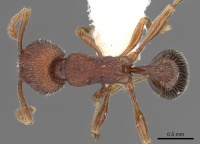Tetramorium granulatum
| Tetramorium granulatum | |
|---|---|

| |
| Scientific classification | |
| Kingdom: | Animalia |
| Phylum: | Arthropoda |
| Class: | Insecta |
| Order: | Hymenoptera |
| Family: | Formicidae |
| Subfamily: | Myrmicinae |
| Tribe: | Crematogastrini |
| Genus: | Tetramorium |
| Species: | T. granulatum |
| Binomial name | |
| Tetramorium granulatum Bolton, 1980 | |
Known from the two workers of the type collection. The labels include this detail "soil at base tree" and the cryptic "Blackpod Project." Blackpod is a Cocao tree (Theobroma cacao) pathogen. This suggests the workers were either found at the base of a Cocao tree or were collected in an area with enough cultivated trees to conduct pathogen studies. In Benin, Taylor et al. (2018) report this species from mango (Mangifera indica) orchards where it is ground nesting.
Identification
Bolton (1980) - Within the flabellum-group only two species, T. granulatum and Tetramorium bellicosum, have a predominantly reticulate-punctate sculpture, elsewhere in the group the sculpture being predominantly or entirely rugular. Of the two punctate species T. granulatum is covered by a fine, dense coat of short, erect hairs whilst in T. bellicosum the pilosity is bizarre, consisting of scattered elongate hairs which are strongly dorsoventrally flattened and are appressed. This difference in pilosity form will quickly separate the two species.
Keys including this Species
Distribution
Distribution based on Regional Taxon Lists
Afrotropical Region: Benin, Nigeria (type locality).
Distribution based on AntMaps
Distribution based on AntWeb specimens
Check data from AntWeb
Countries Occupied
| Number of countries occupied by this species based on AntWiki Regional Taxon Lists. In general, fewer countries occupied indicates a narrower range, while more countries indicates a more widespread species. |

|
Estimated Abundance
| Relative abundance based on number of AntMaps records per species (this species within the purple bar). Fewer records (to the left) indicates a less abundant/encountered species while more records (to the right) indicates more abundant/encountered species. |

|
Biology
Castes
Nomenclature
The following information is derived from Barry Bolton's Online Catalogue of the Ants of the World.
- granulatum. Tetramorium granulatum Bolton, 1980: 299, fig. 83 (w.) NIGERIA.
Unless otherwise noted the text for the remainder of this section is reported from the publication that includes the original description.
Description
Worker
Holotype. TL 3.5, HL 0.82, HW 0.74, CI 90, SL 0.66, SI 89, PW 0.50, AL 0.96. Paratype: TL 3.7, HL 0.82, HW 0.74, CI 90, SL 0.68, SI 92, PW 0.50, AL 0.98. Maximum diameter of eye 0.15.
Mandibles longitudinally striate. Anterior clypeal margin arcuate and entire, without trace of a median impression. Median clypeal carina weak, scarcely stronger than the longitudinal rugulae on the clypeus. Lateral portions of clypeus strongly developed, forming a distinct shield in front of each antennal insertion. Frontal carinae strongly developed to the level of the posterior margins of the eyes, behind this level rapidly merging into the cephalic sculpture. Antennal scrobes shallow, the scapes quite long (SI 89-92 in typeseries). Maximum diameter of eye 0.15, about 0.20 x HW. Dorsal alitrunk without trace of metanotal impression in profile. Propodeum armed with a pair of broad-based, thick, thorn-like spines which are distinctly elevated and shallowly curved along their length. Metapleural lobes low and broadly triangular. Petiole in profile with a thick anterior peduncle and a low long node, the posterodorsal angle obliterated so that the dorsum curves into the posterior face. Postpetiole in profile paniform, very low, shallowly and evenly convex from front to back. In dorsal view the petiole node narrow, longer than broad; postpetiole as long as broad. Dorsum of head with very fine longitudinal rugulae and with a narrow-meshed dense ruguloreticulum occipitally but this sculpture (and that of sides of head) dominated by, and secondary to, a dense reticulate-puncturation which blankets the head capsule. Alitrunk, petiole and postpetiole also entirely covered by dense reticulate-punctate sculpture. The alitrunk also with a few feeble rugulae dorsally which form an irregular reticulum on the pronotum but are longitudinal elsewhere. Rugular sculpture on pedicel segments vestigial. Base of first gastral tergite finely reticulate-punctulate. All dorsal surfaces of head and body very densely covered with fine short hairs, the longest of those on the dorsal alitrunk distinctly much shorter than the maximum diameter of the eye. On the posterior two-thirds of the first gastral tergite the more centrally-situated hairs are directed towards the midline. Dorsal (outer) surfaces of hind tibiae with short, dense, decumbent pubescence. Colour dull red, the gaster slightly darker than the head and alitrunk.
Paratype as holotype.
Type Material
Holotype worker, Nigeria: Gambari, C.R.I.N., 20.viii.1975, ES/1 UHE, soil at base tree, 305 SFA 77-2, blackpod project (B. Taylor) (The Natural History Museum). Paratype. 1 worker with same data as holotype (Museum of Comparative Zoology).
References
- Bolton, B. 1980. The ant tribe Tetramoriini (Hymenoptera: Formicidae). The genus Tetramorium Mayr in the Ethiopian zoogeographical region. Bulletin of the British Museum (Natural History) Entomology. 40(3):193-384.
- Taylor, B., Agoinon, N., Sinzogan, A., Adandonon, A., Kouaguou, Y. N., Bello, S., Wargui, R., Anato, F., Ouagoussounon, I., Houngbo, H., Tchibozo, S., Todjihounde, R., Vayssieres, J.F. 2018. Records of ants (Hymenoptera: Formicidae) from the Republic of Benin, with particular reference to the mango farm ecosystem. Journal of Insect Biodiversity 8(1): 6-29 (doi:10.12976/jib/2018.08.1.2).
References based on Global Ant Biodiversity Informatics
- Bolton B. 1980. The ant tribe Tetramoriini (Hymenoptera: Formicidae). The genus Tetramorium Mayr in the Ethiopian zoogeographical region. Bulletin of the British Museum (Natural History). Entomology 40: 193-384.
- Taylor B., N. Agoinon, A. Sinzogan, A. Adandonon, Y. N'Da Kouagou, S. Bello, R. Wargui, F. Anato, I. Ouagoussounon, H. Houngbo, S. Tchibozo, R. Todjhounde, and J. F. Vayssieres. 2018. Records of ants (Hymenoptera: Formicidae) from the Republic of Benin, with particular reference to the mango farm ecosystem. Journal of Insect Biodiversity 8(1): 006–029.

